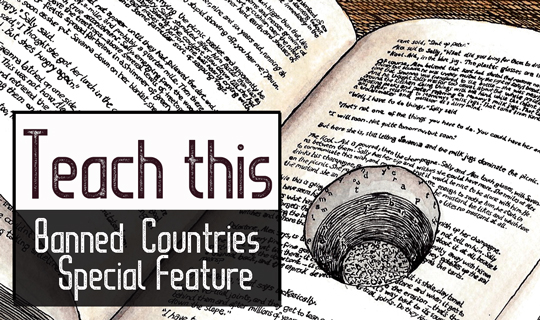Welcome to Teach This, Asymptote for Educators’ answer to the current issue’s Banned Countries Special Feature. We believe that the classroom is the perfect setting for young people to be exposed to diverse, contemporary voices, both allowing them to challenge their assumptions and to engage them with living literature… a conversation in which their own voices matter. To that end, Asymptote for Educators has launched this weekly blog series in which global educators share how and why they would teach the feature’s articles. We hope you and your students enjoy!
Are you an educator with your own lesson plan ideas? Teach This – Banned Countries Special Feature is currently open for submissions. Email education@asymptotejournal.com for more information.
While the work of Ubah Cristina Ali Farah is always situated between two cultures—Somali and Italian—it provides a point of access for students to learn about oral traditions, because despite the author’s long residencies outside of Somalia, these traditions remain present in her writing. Their ubiquity is testament to the very nature of oral stories, which creep into our lives unannounced and perhaps unnoticed, and travel with us. This is how they survive; this is how we survive.
The activities below focus on Ubah Cristina Ali Farah’s use of the Somali oral tradition and the question of personal identity in the context of stories that are passed down and retold, and which have become part of the socio-cultural fabric of our being. Besides offering an introduction to these topics, the lesson provides practice for analysis of a literary text and use of a secondary source to enrich our understanding of literature.
From This Issue: Ubah Cristina Ali Farah’s A Dhow Crosses the Sea, translated by Hope Campbell Gustafson
Learning Objectives:
Students will
- Practice analyzing a literary text
- Practice using secondary sources in their analyses of literary texts
- Learn more about oral traditions and literature (through the example of Somali literature)
Approximate Grade Level(s): Upper-level high school; Undergraduate level (particularly in a first-year academic writing/communication course)
Approximate Length of Class Period(s): 90-120 minutes
Materials Needed:
- A Dhow Crosses the Sea
- Translator’s note
- Ali Jimale Ahmed, “The Somali Oral Tradition and the Role of Storytelling in Somalia”
Lesson Plan
Pre-Class Activity
Ask students to read the short story, the translator’s note, the bios, and Ali Jimale Ahmed’s article before coming to class.
In-Class Activity I
In pairs, have students identify every story within this short story, even the ones that are only hinted at or that are contained in a single phrase or sentence. Challenge them to identify who experienced the story and who has narrated it. Students can use a simple three-column table with the following headings: 1) story; 2) protagonist(s); 3) storyteller(s). When they have finished, have each pair join another to compare their findings.
Pose these questions for a follow-up, whole-class discussion:
- How many stories did you identify?
- Which aspects made you doubt whether to consider a certain mention or passage a story?
- Which stories had unclear or uncertain protagonists or storytellers? Connect your findings to the translator’s note concerning the nature of direct speech in the story.
In-Class Activity II
In groups of three or four, have students use the article (especially pages 1-7) to identify at least three characteristics of the Somali oral tradition that are relevant to A Dhow Crosses the Sea. Ask them to include specific passages from both the article and the short story to illustrate the connections between the two. Debrief answers with the whole group.
Selected questions for further inquiry:
- What could it mean for children to be born without mouths? What other references to mouths do you find in the text and how might they relate to what you have discovered about the oral tradition?
- Ali Jimale Ahmed writes that Somali oral narratives are often built around a central proverb (Ahmed 4). Can you identify a sentence that fulfills this function in the short story?
- Can you think of a connection between the waterfront as the place where one can find stories and the narrator’s grandmother’s hatred for the ocean?
- If Somali stories are didactic (Ahmed 5), what is the lesson to be learned from this story?
- Can you identify the motif of the transformational journey (Ahmed 5-7) in the short story? Do you think a story can “move” the listener to the degree that it can transform them as if the journey had been their own?
- What might be the larger symbolic meaning of the ending, beyond “make sure to put on a bra before you set sail”?
- Who owns a story? The storyteller or the protagonist? And why?
Home Assignment
Use the class discussions and analyses, as well as the short story and article, to write a brief essay on the connection between personal identity and the oral tradition in this short story.
Cristina Serverius is Postdoctoral Research Fellow at the Centre for Education, Law, and Society at Simon Fraser University in British Columbia. She holds graduate degrees from Belgium, the US, and Canada, including a Ph.D. in Comparative Literature from Brown University and an M.Ed. in Curriculum & Instruction from Simon Fraser University. She is currently conducting a story-based evaluation of a whole-school ethic of care model, and is trying to secure the English translation rights to her favorite Belgian-Moroccan author.
*****
Asymptote for Educators wants to see your students’ creations! Submit them to education@asymptotejournal.com for the opportunity have them published in a follow-up to this blog post.

